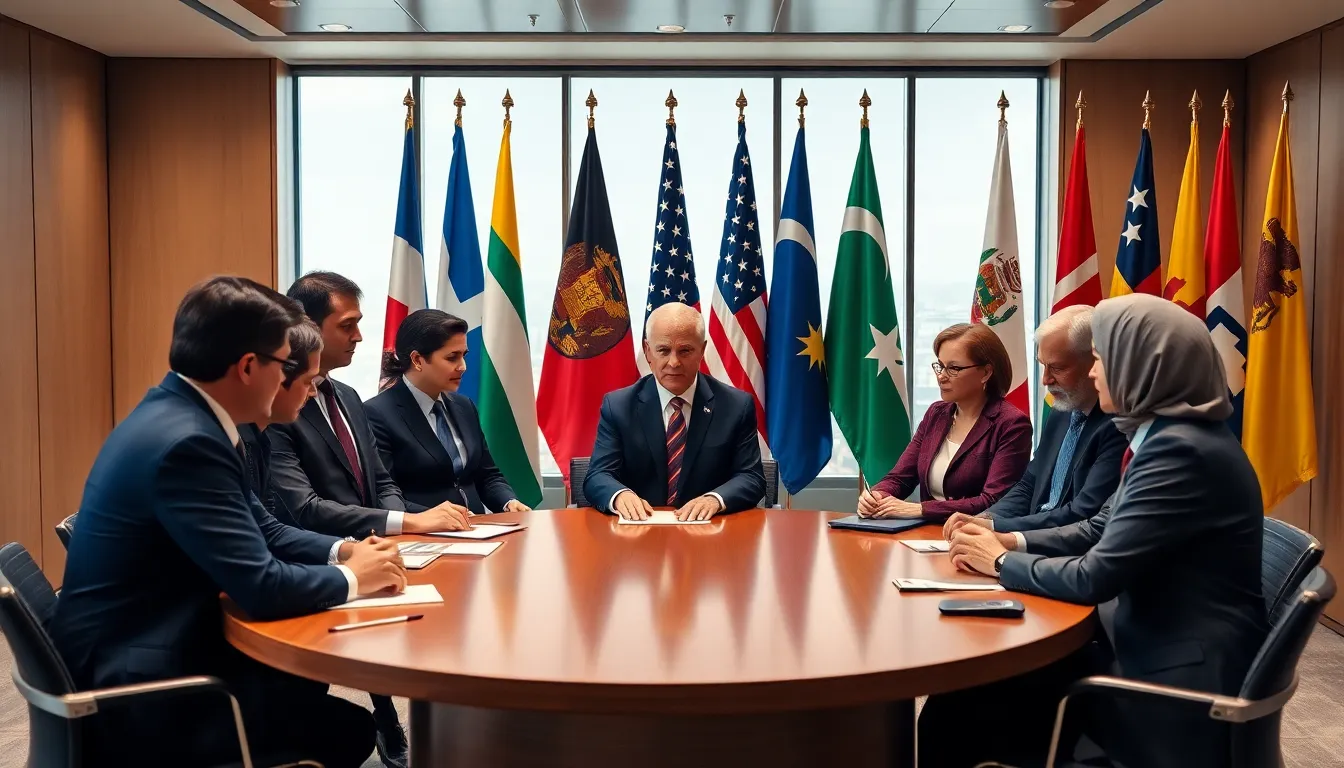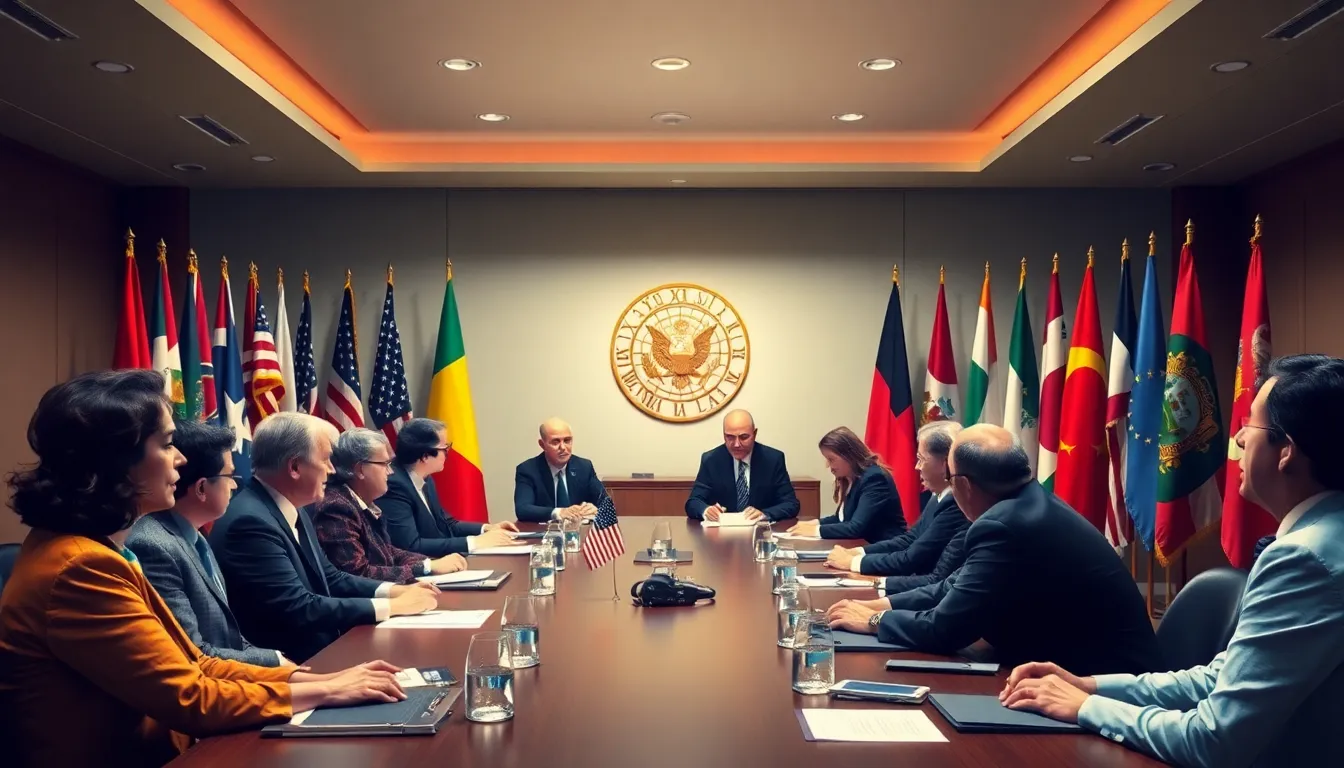In a world where countries often act like siblings fighting over the last cookie, multilateral treaties are the adulting solution to international disputes. These agreements unite multiple nations under a common goal, making sure everyone plays nice—at least on paper. Imagine a diplomatic potluck where everyone brings a dish, but instead of food, it’s promises and commitments to tackle global issues together.
From climate change to trade regulations, multilateral treaties are the unsung heroes of global cooperation. They might not get the spotlight like celebrity treaties, but they’re the backbone of international relations. So, buckle up as we dive into the fascinating world of multilateral treaties, where nations come together, shake hands, and occasionally roll their eyes at each other’s quirks. It’s a diplomatic dance that keeps the world spinning—without the awkward toe-stepping.
Table of Contents
ToggleOverview of Multilateral Treaties
Multilateral treaties represent agreements between three or more countries, facilitating collaborative problem-solving on pressing global issues. Examples include the Paris Agreement on climate change and the Treaty on the Non-Proliferation of Nuclear Weapons. These treaties formalize commitments and establish frameworks for cooperation, enhancing political and economic ties among nations.
Countries engage in multilateral treaties through negotiations, aiming to balance national interests with collective goals. Such treaties often address diverse areas, including human rights, trade, and environmental protection. The United Nations plays a crucial role in promoting and overseeing many of these agreements, serving as a platform for dialogue and collaboration.
These treaties foster an environment of trust, enabling signatory nations to cooperate more effectively. Compliance mechanisms, such as monitoring and reporting, ensure that parties adhere to their commitments. Member states often resort to international courts to resolve disputes arising from these agreements, further solidifying the rule of law in global affairs.
Consideration of multilateral treaties extends beyond legal frameworks. They represent a commitment to shared values and collective security. Nations taking part in these treaties benefit from pooling resources and expertise, which enhances their ability to address global challenges together.
In addition, many multilateral treaties evolve over time, reflecting changes in geopolitics and global priorities. Adjustments to treaties accommodate new scientific data or shifts in diplomatic relations, ensuring their continued relevance. Tracking these developments remains essential for understanding international relations and the evolving landscape of global governance.
Importance of Multilateral Treaties


Multilateral treaties play a vital role in fostering cooperation among nations while addressing common challenges. These agreements serve as pivotal instruments for global collaboration.
Promoting International Cooperation
Multilateral treaties create platforms for dialogue among multiple countries. They enhance diplomatic relations by establishing norms and processes for negotiation. Collective decision-making encourages shared responsibility, increasing accountability among signatories. Countries can effectively align their policies through these agreements, ensuring harmonious relations while addressing mutual interests. These treaties often lead to joint initiatives, leading to efficient resource sharing. The interplay between nations strengthens the framework of international law.
Addressing Global Issues
Global challenges, such as climate change and human rights violations, require multilateral responses. Treaties provide structured methods to tackle these pressing issues collectively. Collaborative efforts draw on the strengths of individual countries, enhancing the effectiveness of proposed solutions. For instance, agreements like the Paris Agreement demonstrate collective commitment to combatting climate change. Furthermore, multilateral treaties facilitate coordination, allowing countries to monitor progress and adapt strategies as needed. Access to shared knowledge and resources proves crucial in addressing threats to global security and health. These treaties also promote sustainable development by uniting nations toward a common goal.
Types of Multilateral Treaties
Multilateral treaties encompass various categories that reflect nations’ collaborative objectives. Three primary types include economic treaties, environmental treaties, and security treaties.
Economic Treaties
Economic treaties facilitate international trade and investment. They establish rules that govern economic interactions among nations, promoting trade partnerships and market access. Examples include the North American Free Trade Agreement (NAFTA) and the Regional Comprehensive Economic Partnership (RCEP). By reducing tariffs and implementing trade standards, these agreements stimulate economic growth and enhance cooperation. Nations benefit from increased trade opportunities and shared economic interests, reinforcing regional and global economic stability.
Environmental Treaties
Environmental treaties focus on global ecological challenges. They aim to address issues such as climate change, biodiversity loss, and pollution control. Prominent examples include the Paris Agreement and the Convention on Biological Diversity. These treaties set targets for emission reductions and biodiversity protection, fostering collaboration among signatories. Countries share resources, technology, and expertise to combat shared environmental threats. Collaborative action enhances sustainability efforts and encourages nations to create a healthier planet for future generations.
Security Treaties
Security treaties promote collective defense and cooperation against threats. They establish frameworks for military alliances and conflict resolution among countries. The North Atlantic Treaty Organization (NATO) serves as a key example, providing a security umbrella for its member nations. These agreements enhance stability in volatile regions and deter aggression through mutual defense commitments. Nations strengthen their security ties, enabling coordinated responses to potential threats. Through collaboration, security treaties reinforce global peace and stability in an increasingly complex world.
Key Challenges in Multilateral Treaties
Multilateral treaties face several key challenges that can hinder their effectiveness. Understanding these challenges is crucial for enhancing global cooperation.
Compliance and Enforcement
Compliance remains a significant obstacle in multilateral treaties. Nations might prioritize national interests over treaty obligations, leading to selective adherence. Enforcement mechanisms often lack robustness, as treaties depend heavily on the willingness of states to comply. Monitoring compliance can prove difficult, especially when states resist transparency. International institutions can help by facilitating audits and reports, but they cannot compel adherence without cooperation. Non-compliant behavior undermines collective efforts, creating tensions among member states. A structured approach, including clear penalties and incentives, can improve compliance rates.
Negotiation Difficulties
Negotiating multilateral treaties involves intricate dynamics. Diverse perspectives and interests complicate consensus-building, as countries often pursue conflicting goals. Language barriers can obstruct clear communication, resulting in misunderstandings. Additionally, power imbalances among nations might lead to dissatisfaction with negotiated terms. Significant time and resources are often required to reach agreements, which can delay urgent actions. Inclusivity in negotiations can enhance engagement, making it easier to address concerns. Building trust through ongoing dialogue and established relationships among nations can foster more productive negotiations in the future.
Future of Multilateral Treaties
Multilateral treaties are set to adapt and evolve in response to ongoing global challenges. Their significance remains clear as nations prioritize collaborative frameworks for addressing pressing issues.
Trends and Developments
Emerging trends showcase a shift in focus toward inclusivity and sustainability. Countries increasingly seek to incorporate diverse voices in treaty negotiations, fostering broader representation of interests. Environmental concerns dominate discussions, as nations recognize the urgency of climate action. The rise of regional agreements also highlights a trend toward localized solutions that address specific challenges more effectively. Growing public awareness further encourages governments to commit to strong multilateral frameworks. Asia’s active engagement in forming new treaties illustrates this trend in action.
The Role of Technology
Technology transforms how nations approach multilateral treaties. Digital platforms streamline communication, enhancing negotiation processes and increasing efficiency. Countries can utilize data analytics to monitor treaty compliance and measure outcomes more effectively. Moreover, technology facilitates information sharing, allowing states to respond swiftly to emerging challenges. Artificial intelligence finds applications in analyzing treaty impacts, providing insights that guide future agreements. Collaborative tools also support remote negotiations, making it easier to engage stakeholders from various regions. As these technological advancements unfold, their potential to reshape multilateral diplomacy grows significantly.





